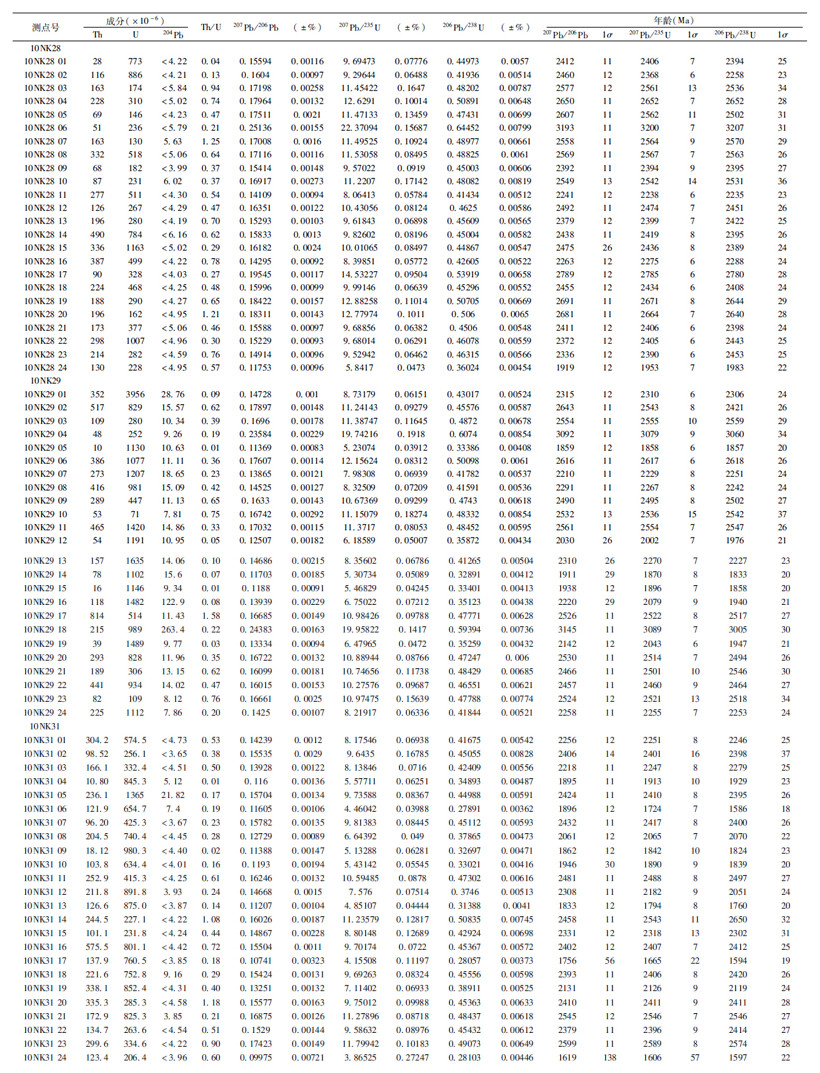2. 朝鲜国家科学院地质研究所, 平壤 3812100
2. Institute of Geology, State Academy of Sciences, Pyongyang 3812100, DPRK
中朝克拉通是世界上面积最大的古老克拉通之一,始太古岩石出露于辽宁鞍山、冀东曹庄等地(Jahn et al.,1987; Liu et al.,1992; Song et al.,1996; Wan et al.,2005,2012,2013; Wang et al.,2015; Wu et al.,2008; 刘敦一等,2007; 吴福元等,2005),华北南缘中生代火山岩中的下地壳麻粒岩包体,指示中朝克拉通早太古代基底的存在范围可能远大于目前所识别的几个地区(Zheng et al.,2004)。冥古宙的锆石U-Pb年龄信息,在中朝克拉通也多有报道(Cui et al.,2013; Diwu et al.,2013; Wang et al.,2007)。从太古宙到元古宙,中朝克拉通先后经历了:(1) 太古宙巨量陆壳增生,并在太古宙晚期通过微陆块拼合完成第一期克拉通化;(2) 古元古代早期的构造静寂期以及随后的裂解-俯冲-碰撞和第二期克拉通化;(3) 中-新元古代长期而持续的裂解事件;(4) 丰富而复杂的成矿作用(Guo et al.,2015; Kusky,2011; Peng et al.,2011,2014; Santosh et al.,2013; Zhai,2014,2015; Zhai and Santosh,2013; Zhai et al.,2014; Zhai and Zhou,2015; Zhao,2014; Zhao et al.,2012,2016; Zhao and Zhai,2013; Niu et al.,2015)。
作为中朝克拉通重要组成部分的朝鲜半岛,以其特殊性吸引了众多研究者。根据岩石组合、构造特征和地质年代学等方面的认识,朝鲜半岛可以被细分为不同的构造单元,如冠帽(Kwanmo)、狼林(Nangrim或Rangnim)、京畿(Gyeonggi)和岭南(Yeongnam或Ryongnam)等四个地块,平南盆地(Pyongnam)、太白山盆地(Taebaesan)和庆尚盆地(Gyeongsang)等三个主要的沉积盆地,临津江带(Imjinggang或Rimjingang)和沃川带(Ogcheon)等两个构造带(图 1; Chang,1996; Chough et al.,2000; Ree et al.,1996; Yin and Nie,1993; Zhai et al.,2007a)。狼林地块、京畿地块和岭南地块都是出露有太古宙-古元古代基底的前寒武纪地体(Kim et al.,2008; Kwon,2003; Lee et al.,2005,2014; Wu et al.,2007a,b; Zhai et al.,2005,2007a,b; Zhao et al.,2006),而冠帽地块则被认为可能代表兴-蒙造山带(亚洲中部造山带)的一部分(Peng et al.,2008,2011)。从地表出露岩石来看,平南盆地属中元古代到古生代,太白山盆地属古生代,而庆尚盆地属中生代,三者分别沉积于狼林地块、京畿地块和岭南地块的基底岩石之上(Chough et al.,2000)。临津江带主要由记录了晚二叠-早三叠高级变质作用的岩石组成,沃川带则主要由新元古代到古生代的沉积岩和变质火山岩以及中生代花岗岩侵入体组成,新元古代和早古生代岩石记录了古生代中期和三叠纪的多期变质变形作用(Cheong et al.,2003; Min and Cho,1998)。

|
图 1 朝鲜半岛构造单元划分以及前寒武纪岩石分布图(a,据Chough et al.,2000; Zhao et al.,2006; Peng et al.,2008修改)、朝鲜半岛在中朝克拉通的位置(b,据Peng et al.,2014修改)和研究区地质简图(c) 图a中的两个星号代表Zhao et al.(2006) 所报道的2个太古宙灰色片麻岩的采样点位置 Fig. 1 Tectonic units of the Korea Peninsula and distribution of the Precambrian rocks(a,modified after Chough et al.,2000; Zhao et al.,2006; Peng et al.,2008),location of the Korean Peninsula in Sino-Korea Craton(b,after Peng et al.,2014)and geological sketch map of the study area(c) represent the locations of the two Archean grey gneiss samples reported by Zhao et al.(2006) |
朝鲜半岛最北端的狼林地块,目前多数研究者认为狼林地块是中朝克拉通的重要组成部分(Chough et al.,2000; Faure et al.,2004; Li et al.,2006; Zhai et al.,2007a; Zhao et al.,2006; 白瑾,1993; 张秋生,1988),Kim and Jon(1996) 、Lyang et al.(2009) 、Ri(1996a)和Zhao et al.(2006) 报道了狼林地块的太古宙年龄信息,认为狼林地块具有与华北类似的太古宙基底岩石组成。Wu et al.(2007b)和吴福元等(2016) 的研究表明,源于狼林山的河沙所显示的年龄峰值大部分在古元古代以及中生代,太古宙的年龄值仅占极小部分。Zhai et al.(2007b)、Zhao et al.(2006) 和赵磊等(2016) 等研究发现,狼林地块在古元古代经历了与华北三条古元古代活动带类似的高温变质-深熔以及同期或稍晚的非造山岩浆活动,这些变质-深熔以及岩浆活动的时间与Wu et al.(2007b)和吴福元等(2016) 报道的河沙年龄峰值一致。综合前人的研究结果并结合新的数据,以及通过广泛的区域对比,吴福元等(2016) 认为狼林地块可能是与辽吉带基本类似的古元古代地体,属于华北克拉通在古元古代期间东南大陆边缘的巨型造山带的一部分;狼林地块存在的一些太古代岩石(Zhao et al.,2006,等),可能与辽南的太古代岩石类似,代表分布于这一巨型古元古代构造带中的零星块体。
为了进一步丰富狼林地块的年代学信息,并深化对狼林地块基底岩石形成时代及其存在规模的认识,本文选取位于平南盆地东侧的狼林群花岗片麻岩为研究对象,通过详细的岩相学、锆石U-Pb年代学研究并结合与华北克拉通的对比,确认在狼林地块东缘也存在与华北克拉通辽南地块类似的太古宙岩石,这些岩石在古元古代时期遭受强烈的构造热事件的改造。这一研究结果,将会为全面理解中朝克拉通太古宙到古元古代地质年代格架和区域地质演化提供重要的素材。
2 地质背景与样品据早期的地质资料可知,狼林地块早前寒武纪基底岩石组成主要包括太古宙狼林群、古元古代甄山群(Jungsan)、摩天岭系(Machollyong System)、黄海群(Hwanghae)以及时代与之相当的一系列遭受强烈变形和混合岩化作用的中酸性侵入岩(Kim and Jon,1996; Paek and Jon,1996; Ri,1996a,b)。研究区位于狼林地块东南侧(平南盆地东缘)的高城(Kosong)-金江(Kumgang)一带,区内分布的岩石类型主要为中生代谭川(Tanchon)花岗岩杂岩体,早前寒武纪岩石为狼林群花岗片麻岩,新元古代钙质砾岩以及石英岩在区内也有分布(图 1)。根据朝鲜方面的总结(Kim and Jon,1996; Lyang et al.,2009),太古宙狼林群主要岩石类型包括黑云母片麻岩、堇青石黑云母片麻岩、石榴堇青石片麻岩、紫苏辉石片麻岩、石英岩、石墨片麻岩、片岩、角闪岩、大理岩和各类混合岩,岩石普遍经受麻粒岩相变质作用,其中特征的岩石包括紫苏辉石片麻岩和石墨片麻岩(Kim and Jon,1996)。早期Sm-Nd同位素测试结果表明,狼林群紫苏辉石片麻岩的时代为3180~2951Ma(Lyang et al.,2009)。然而由于缺乏系统的微区锆石U-Pb年代学数据,并且难以确认这些传统方法获得的年龄数据究竟属于全岩Sm-Nd模式年龄还是等时线年龄(全岩或者单矿物+全岩?),因此很难准确理解这些年代学数据所代表的具体地质含义。
Zhao et al.(2006) 曾经报道了2个属于狼林群的太古宙灰色片麻岩样品的年龄(SHRIMP锆石U-Pb年龄),分别为2538±14Ma(样品号PO501)和2636±49Ma(样品号K14)(图 1)。其中PO501采自于狼林地块南缘的开城一带,K14采自于狼林地块东南缘的高城附近,两个采样点均位于狼林地块与临津江带(京畿地块)的接触带附近。本文所研究的3个样品采自于朝鲜江原道通川郡桑阴里(Sangum-ri)海边(图 1),包括2个花岗片麻岩样品(10NK28和10NK29)以及1个含长石斑晶的花岗片麻岩(10NK31)。从野外露头以及手标本的情况可以看出,花岗片麻岩发育有明显的片麻理,局部还存在由混合岩化作用所形成的浅色脉体,而含长石斑晶的花岗片麻岩片麻理稍弱(图 2)。3个样品均具有类似的矿物组合:黑云母+斜长石+钾长石+石英+白云母以及副矿物,如锆石和榍石等。从岩相观察结果来看,它们的原始花岗结构已经被后期变质变形所改造,呈现花岗变晶结构(图 3)。
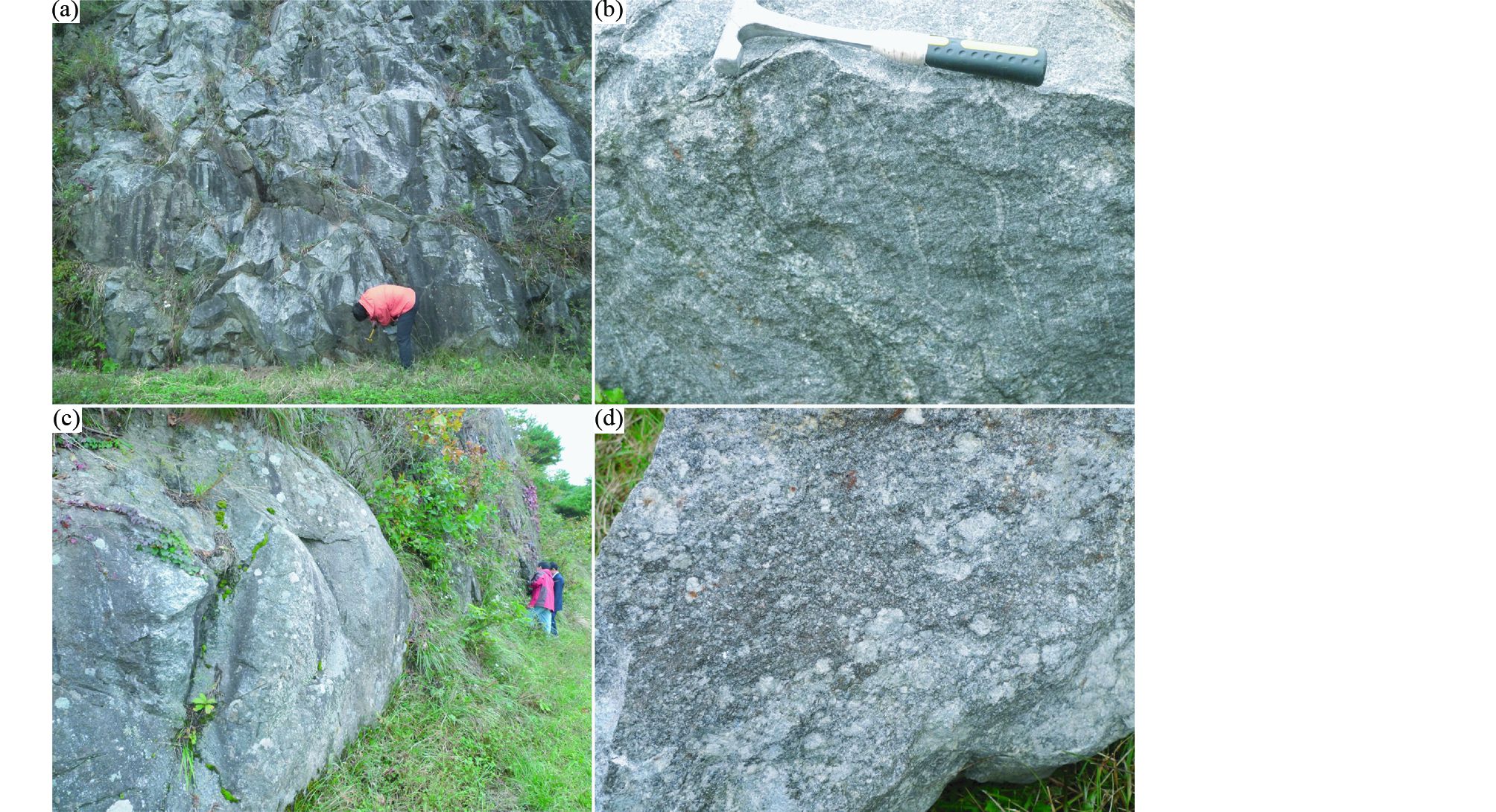
|
图 2 狼林群中花岗片麻岩的野外露头照片 (a、b)10NK28和10NK29;(c、d)10NK31 Fig. 2 Outcrop photos of the granitoid gneisses from the Rangnim Group |

|
图 3 狼林群中花岗片麻岩的岩相照片 (a、b)10NK28;(c、d)10NK29;(e、f)10NK31. 矿物缩写:Pl-斜长石;Kf-钾长石;Qtz-石英;Bt-黑云母;Mu-白云母 Fig. 3 Photomicrographs of the granitoid gneisses from the Rangnim Group Mineral abbreviates: Pl-plagioclase; Kf-K-feldspar; Qtz-quartz; Bt-biotite; Mu-muscovite |
本文对上述的3件样品分别采用LA-ICPMS方法和SIMS方法进行了锆石U-Pb年龄测试,在采用LA-ICPMS方法定年过程中,同时分析了锆石的微量元素含量。样品的前处理过程大致如下:首先对每件样品(约3kg)进行破碎,而后采用标准重液和磁选从破碎样中分选出锆石颗粒(不少于800粒);其次,在双目镜下对每个样品中选出的锆石进行粘靶,粘靶时对大、中、小颗粒的锆石均匀选取,每件样品粘靶的锆石颗粒数量均不少于200颗;粘靶完成后,对每件样品的锆石进行透反射光和阴极发光(CL)照相。锆石的CL图像在中国科学院地质与地球物理研究所电子探针与电镜实验室完成。对于进行SIMS锆石U-Pb定年的样品,将样品靶在真空下镀金以备分析。
锆石的LA-ICP-MS在中国科学院地质与地球物理研究所多接收-电感耦合等离子体质谱实验室完成。该实验室的激光剥蚀等离子体质谱仪(LA-ICP-MS)可以同时完成锆石U-Pb年龄测试和锆石的微量元素分析,仪器型号以及实验测试流程的描述参见(谢烈文等,2008)。实验测试过程中,选取NIS610玻璃作为校正外标,Si作为校正内标,91500锆石作为U-Pb同位素分馏效应的校正外标(Wiedenbeck et al.,1995),GJ-1作为监控盲样。实验测得的GJ-1的206Pb/208U表面年龄分布在605~619Ma之间,与推荐值613±6Ma基本一致(Elhlou et al.,2006; 谢烈文等,2008)。使用Andersen(2002) 推荐的方法进行普通铅校正,并使用ISOPLOT软件对锆石U-Pb测试数据进行相关处理(Ludwig,2003)。SIMS锆石的U-Th-Pb测试在中国科学院地质与地球物理研究所CAMECA IMS-1280二次离子质谱仪(SIMS)上进行,详细分析方法见Li et al.(2009) 。锆石标样与锆石样品以1∶3比例交替测定。U-Th-Pb同位素比值用标准锆石Plésovice(337Ma,Sláma et al.,2008)校正获得,U含量采用标准锆石91500(81×10-6,Wiedenbeck et al.,1995)校正获得,以长期监测标准样品获得的标准偏差(1SD=1.5%,Li et al.,2010)和单点测试内部精度共同传递得到样品单点误差,以标准样品Qinghu(159.5Ma,Li et al.,2009)作为未知样监测数据的精确度。普通Pb校正采用实测204Pb值。由于测得的普通Pb含量非常低,假定普通Pb主要来源于制样过程中带入的表面Pb污染,以现代地壳的平均Pb同位素组成(Stacey and Kramers,1975)作为普通Pb组成进行校正。同位素比值及年龄误差均为1σ。数据结果处理采用ISOPLOT软件(Ludwig,2003)。
4 测试结果3个样品的锆石CL图像、稀土配分曲线以及锆石U-Pb年龄结果如图 4、图 5、图 6和图 7所示,具体的LA-ICPMS锆石U-Pb年龄结果和微量元素结果见表 1和表 2,SIMS锆石U-Pb分析结果见表 3。从下面的描述可知,3个样品的锆石所显示的复杂内部结构特征,严重制约了LA-ICPMS方法获得年龄数据的质量,这也是我们综合使用两种定年方法的原因。
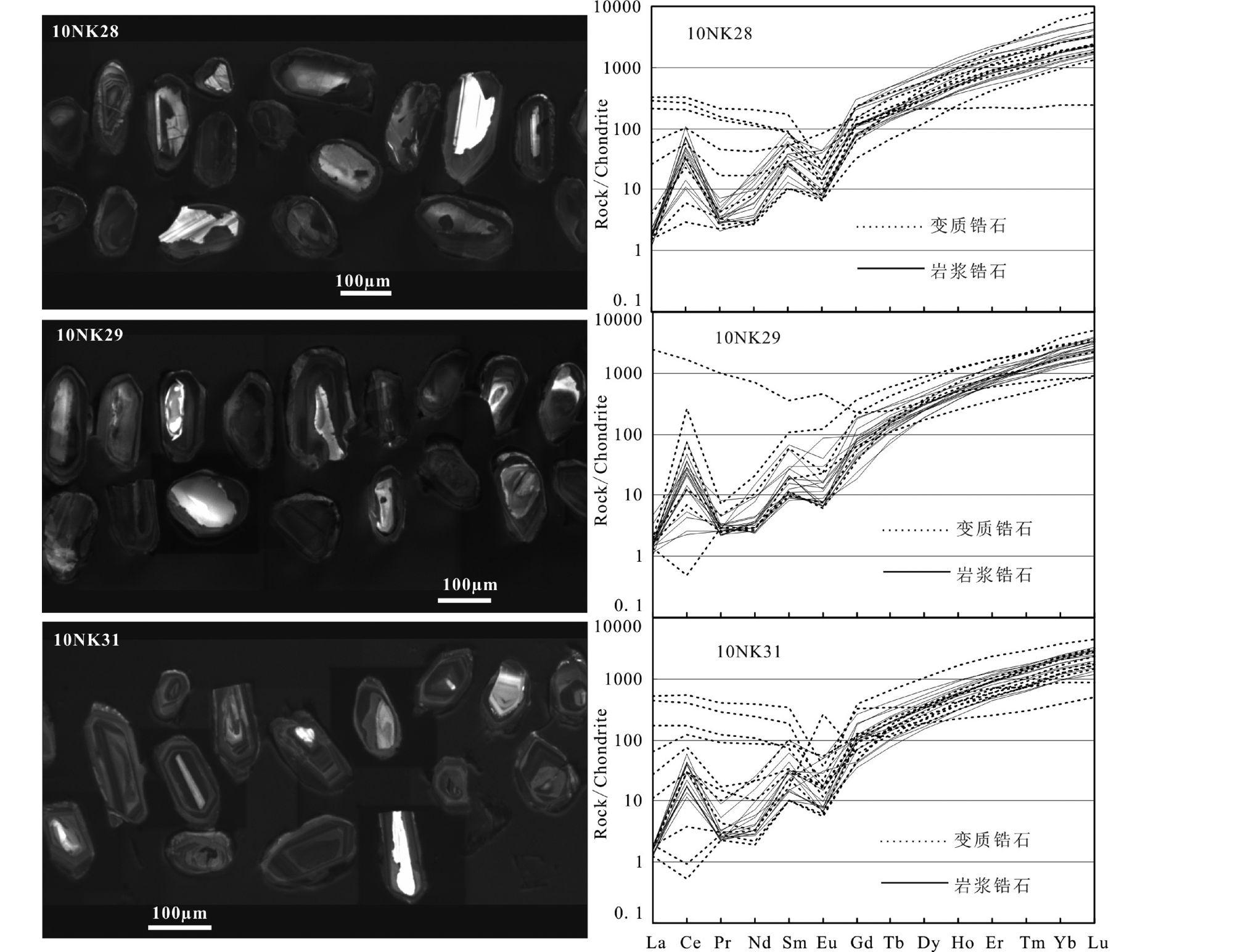
|
图 4 狼林群样品锆石的CL图像和球粒陨石标准化稀土配分曲线(标准化值据Sun and McDonough,1989) Fig. 4 CL images and chondrite-normalized REE patterns(normalization values after Sun and McDonough,1989)of zircons from the three samples from the Rangnim Complex |

|
图 5 狼林群样品LA-ICPMS锆石U-Pb年龄谐和图以及207Pb/206Pb年龄与Th/U比值关系图 Fig. 5 LA-ICPMS zircon U-Pb concordia diagrams of the samples from the Rangnim Complex and the 207Pb/206Pb vs. Th/U ratio diagram of all the three samples of this study |
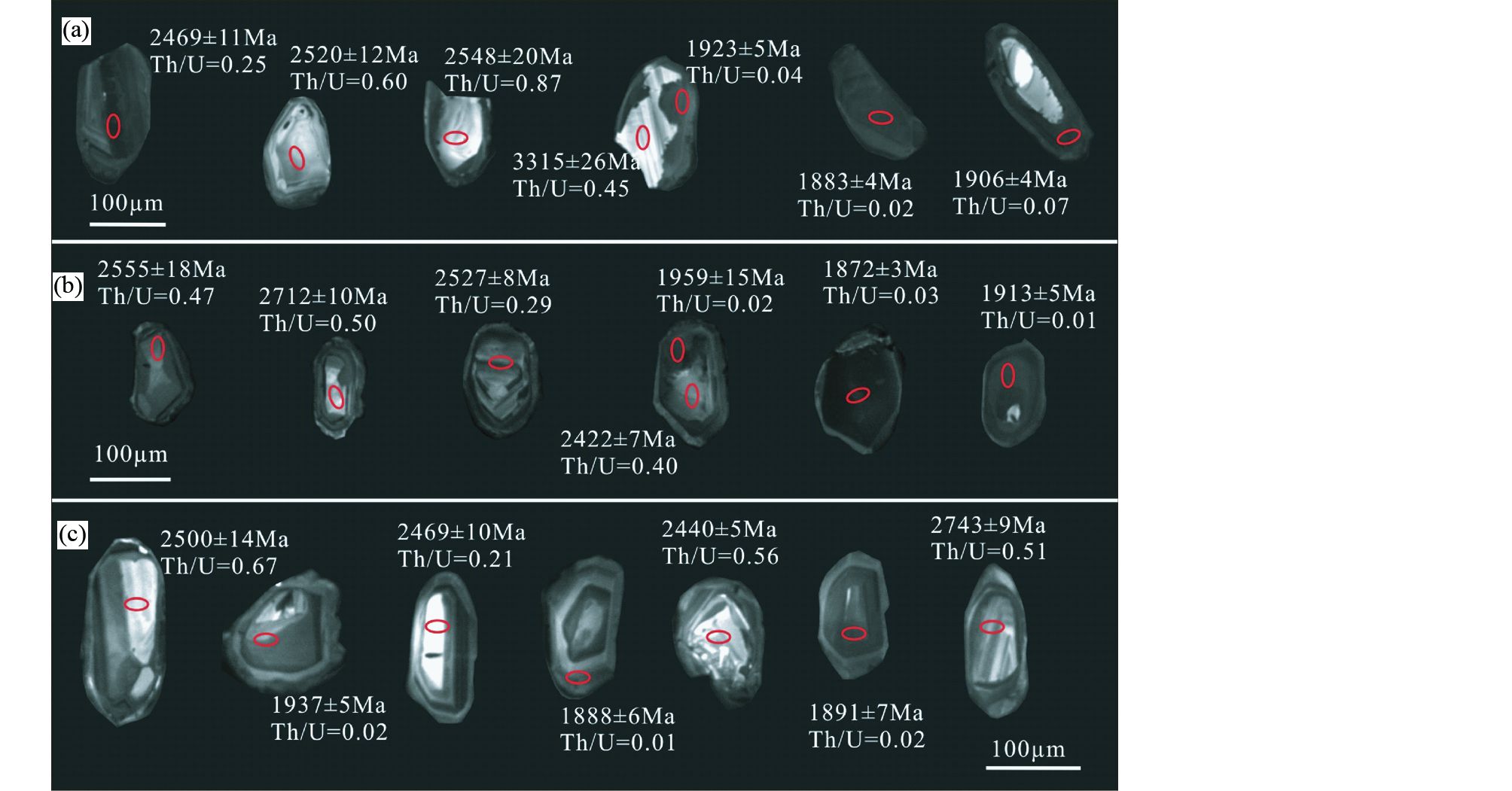
|
图 6 狼林群样品锆石的CL图像和SIMS锆石U-Pb测试结果 Fig. 6 CL images and SIMS U-Pb results of zircons from the three samples from the Rangnim Complex |
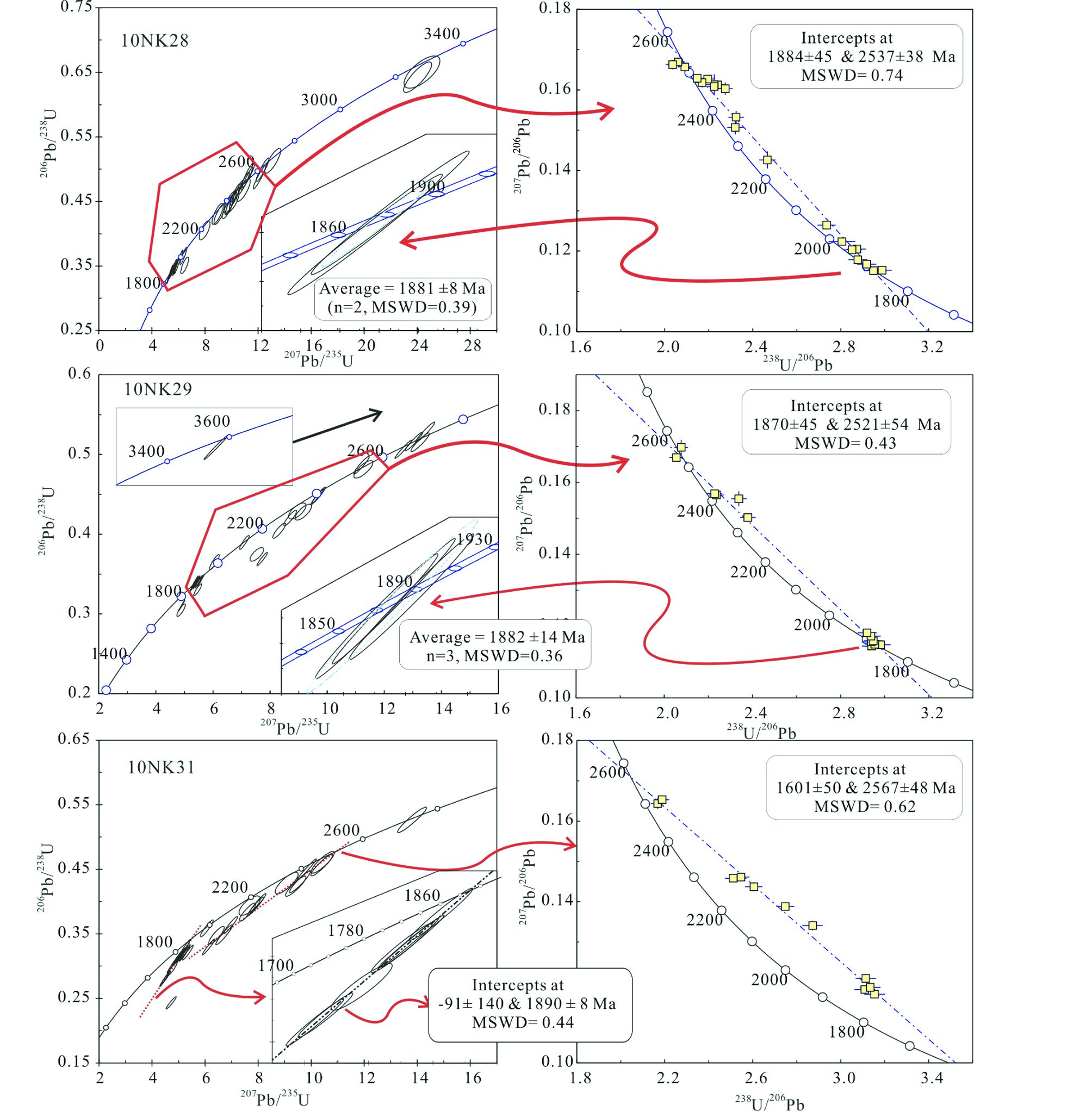
|
图 7 狼林群样品SIMS锆石U-Pb年龄谐和图 Fig. 7 SIMS zircon U-Pb concordia diagrams of the samples from the Rangnim Complex |
|
|
表 1 狼林群样品的锆石U-Pb定年结果 Table 1 Zircon U-Pb results of the three samples from Rangnim Complex |
3个样品的锆石显示类似的形态和内部结构特征,大部分锆石发育核边结构,而且核部的发光性一般强于锆石边部,锆石核多显示岩浆振荡环带,而锆石边则显示弱的振荡环带或者不显示环带特征。3个样品中的锆石都既有长棱柱状锆石,又有短的浑圆状锆石,长棱柱状锆石的颗粒边界显示明显的"圆化"特征。从锆石的稀土配分曲线可以看出,对应于锆石的形态和内部结构特征,3个片麻岩样品中的锆石也可以大致分为两组,一组锆石的稀土含量较为稳定,并且显示较为明显的重稀土富集、轻稀土亏损以及强烈的正Ce异常(图 4);另外一组锆石的稀土含量变化范围较大,并且部分锆石表现出重稀土平坦的特征(图 4),这部分锆石的生长可能受到石榴石生长的影响(Rubatto,2002)。207Pb/206Pb年龄在1619Ma到2599Ma之间,Th/U比值在0.01到1.18之间,其中仅207Pb/206Pb年龄分别为1895Ma和1862Ma的两颗锆石的Th/U比值小于0.1(表 1)。在锆石U-Pb谐和图上,24个测试结果凌乱分布,其中几个点集中在2407±17Ma(n=7)(图 5)。在207Pb/206Pb年龄和Th/U比值关系图解上,年龄和Th/U比值呈现一定的正相关关系(图 5)。
4.1 LA-ICPMS分析结果花岗片麻岩样品10NK28中的24测试点的207Pb/206Pb年龄,分布于1919Ma到3193Ma之间,Th/U比值在0.04到1.25之间,其中仅1颗锆石的Th/U比值小于0.1,其207Pb/206Pb年龄为2412±11Ma(表 1)。在锆石U-Pb谐和图上,24个测试点主要集中于3个年龄组,分别为2674±53Ma(n=3)、2573±28Ma(n=5)以及2416±27Ma(n=7)。这三组年龄为锆石核部的测试结果,由于LA-ICPMS分析过程中的束斑较大,有部分测试点可能既包含核部又有边部,1919Ma的年龄则来自于锆石边部。在207Pb/206Pb年龄和Th/U比值关系图解上,二者呈现一定的正相关关系(图 5)。
另1个花岗片麻岩样品10NK29中的24个测试点的207Pb/206Pb年龄,在1859Ma到3145Ma之间,Th/U比值在0.01到1.58之间。表面年龄在1859Ma到2142Ma的几个测试点的Th/U比值均小于0.1,而207Pb/206Pb年龄在2457Ma到3145Ma之间的测试点的Th/U比值均大于0.1(表 1)。在锆石U-Pb谐和图上,24个测试点主要集中于两组:2539±17Ma(n=6)和2277±57Ma(n=3)。前一组锆石为锆石核部的测试结果,而后一组则是锆石核部和边部混合的测试结果。在207Pb/206Pb年龄和Th/U比值关系图解上,二者呈现较为明显的正相关关系(图 5)。
|
|
表 2 狼林群样品锆石的稀土元素含量分析结果(×10-6) Table 2 Zircon REE results of the three samples from the Rangnim Complex(×10-6) |
|
|
表 3 狼林群样品的SIMS锆石U-Pb定年结果 Table 3 SIMS zircon U-Pb results of the three samples from the Rangnim Complex |
SIMS锆石U-Pb年龄分析结果在图 6和图 7中,锆石的207Pb/206Pb与Th/U关系图见图 8。花岗片麻岩样品10NK28中的29测试点的207Pb/206Pb年龄,分布于1881Ma到3315Ma之间,Th/U比值在0.003到1.171之间,其中207Pb/206Pb年龄小于2000Ma年的锆石Th/U比值均小于0.1(表 3)。锆石核部的年龄大都在2.5Ga左右,2个锆石核获得了3.1Ga左右的年龄值。锆石边部以及不发育环带结构的锆石207Pb/206Pb年龄多在1.9Ga左右。29个测试点中的一部分结果,组成一条不一致曲线,不一致曲线的上交点年龄为2537±38Ma,下交点年龄为1884±45Ma,其中下交点附近的两个谐和年龄结果的加权平均值为1881±8Ma(图 7)。在207Pb/206Pb年龄和Th/U比值关系图解上,二者呈现明显的正相关关系(图 8)。

|
图 8 狼林群样品锆石207Pb/206Pb年龄与Th/U比值关系图(基于锆石的SIMS分析测试结果) Fig. 8 The 207Pb/206Pb vs. Th/U ratio diagram of all the three samples of this study(based on SIMS results) |
花岗片麻岩样品10NK29中的31测试点的207Pb/206Pb年龄,分布于1871Ma到3586Ma之间,Th/U比值在0.006到0.702之间,其中207Pb/206Pb年龄小于1959Ma年的锆石Th/U比值均小于0.1(表 3)。锆石核部的年龄大都大于2.0Ga,1个锆石核获得了3.6Ga左右的年龄值。锆石边部以及不发育环带结构的锆石207Pb/206Pb年龄多在1.9Ga左右。31个测试点中的一部分结果,组成一条不一致曲线,不一致曲线的上交点年龄为2521±54Ma,下交点年龄为1870±45Ma,其中下交点附近的3个谐和年龄结果的加权平均值为1882±14Ma(图 7)。在207Pb/206Pb年龄和Th/U比值关系图解上,二者呈现明显的正相关关系(图 8)。
含长石斑晶花岗片麻岩样品10NK31中的31测试点的207Pb/206Pb年龄,分布于1872Ma到2743Ma之间,Th/U比值在0.009到0.665之间,其中207Pb/206Pb年龄小于2.0Ga的大部分锆石的Th/U比值小于0.1(表 3)。由于含长石斑晶花岗片麻岩样品中锆石含有较高的U含量,其锆石表现出更为明显的Pb丢失,31个测试点中的一部分结果,组成两条不一致曲线,其中一条不一致曲线的上交点年龄为2567±48Ma,另外一条不一致曲线的上交点年龄为1890±8Ma(图 7)。在207Pb/206Pb年龄和Th/U比值关系图解上,二者呈现明显的正相关关系(图 8)。
5 讨论与结论锆石形态、内部结构以及微量元素特征的研究,极大地促进了人们对于锆石成因矿物学的理解和认识,并进而对解释锆石U-Pb年代所代表的实际地质意义产生了很好的制约(Chen et al.,2011; Corfu et al.,2003; Geisler et al.,2003; Hoskin and Black,2000; Hoskin and Schaltegger,2003; Rubatto,2002; Rubatto et al.,1999; Vavra,1990; Wu et al.,2006; Zheng et al.,2005)。目前人们对锆石的认识已经不仅局限在变质锆石、岩浆锆石和热液锆石等大致的分类,针对这三大类中的每类锆石,都有不同的进一步详细划分,尤其是变质锆石。固态重结晶锆石是变质改造锆石的一个重要分类,经历固态重结晶的锆石往往由于重结晶作用不完全,而不同程度继承原来锆石的形态、内部结构和微量元素组成,新生锆石的U-Pb计时体系可能是原来锆石U-Pb体系彻底重置或者部分重置的结果(Hoskin and Black,2000; Zhao et al.,2015)。本文所研究的3个片麻岩中的锆石大都发育核边结构,核部环带特征明显,Th/U比值高,并且具有稳定的稀土含量、强烈的轻重稀土分异,属于典型的岩浆成因锆石(Harley and Kelly,2007; Hoskin and Schaltegger,2003; Rubatto et al.,1999; Vavra,1990);而锆石边以及部分浑圆状锆石颗粒则显示无环带或显示弱的环带,并且锆石边部显示多晶面并且的圆化特征,虽然部分LA-ICPMS分析结果显示锆石边部具有高的Th/U比值,利用SIMS方法分析的锆石边部均具有有低的Th/U比值(图 7和图 8),属于典型的变质锆石(Harley and Kelly,2007; Hoskin and Schaltegger,2003; Rubatto et al.,1999; Vavra,1990)。综合两种方法所获得的结果,可以认为LA-ICPMS方法获得的部分锆石的高Th/U比值,可能是混合的测试的结果。2个花岗片麻岩锆石核部的LA-ICPMS分析结果:2573±28Ma(10NK28)和2539±17Ma(10NK29),与3个样品锆石核部的SIMS分析结果:2537±38Ma(10NK28)、2521±54Ma(10NK29)和2567±48Ma(10NK31)一致,可能代表了花岗岩类的岩浆结晶时间,而几颗零星的年龄大于~2.6Ga的锆石,可能属于继承锆石或者岩浆捕获锆石。3.1Ga以及3.6Ga年龄的存在,表明狼林地块存在古太古代甚至始太古代的物质。两种分析测试方法均从3个片麻岩样品的锆石边部或者变质锆石中获得了1.87~1.89Ga的锆石年龄,这一年龄结果代表了古元古代构造热事件发生的时代。这些从锆石边部获得的年龄值与狼林地块普遍发育的麻粒岩相变质-深熔的时间一致(Zhao et al.,2006; 赵磊等,2016),可能代表了一期发生于古元古代的构造热事件的时代。值得注意的是,LA-ICPMS方法获得了一些存在于2.5~1.9Ga之间的年龄结果,通过对比SIMS方法获得年龄结果,推测这些年龄值可能代表锆石核部和边部的混合年龄,或者代表由固态重结晶所造成的U-Pb计时体系不完全重置的结果(Hoskin and Black,2000; Zhao et al.,2015),不具有实际的地质意义。
在朝鲜半岛的构造格局划分中,不同学者对临津江带的范围有不同的认识(Chang,1996; Choi et al.,2006; Chough et al.,2000; Paek and Jon,1996; Yin and Nie,1993)。在不同的划分类别中,Zhao et al.(2006) 所报道的开城-高城一带可分别属于狼林地块东南缘或者属于临津江带。基于前人对临津江带岩石组合、变质和变形特征以及时代的描述(主要由记录了晚二叠-早三叠高级变质作用的岩石组成,Chough et al.,2000; Ree et al.,1996),本文将开城-高城一带划属狼林地块。前面已经提到,Wu et al.(2007a,b)和吴福元等(2016) 通过系统研究源自于狼林地块的河流河沙以及岩浆活动,提出古元古代巨型造山带的概念,并且认为辽南地区的太古宙岩石(路孝平等,2004),可能代表残存于辽-吉-朝古元古代地体中的一些太古宙块体,并不代表大规模古老基底岩系。本文从狼林地块东南缘狼林杂岩中获取的太古宙岩浆活动的年龄信息,基本可以与辽南的太古宙岩石相对比。综合本文以及前人研究成果可知,在平南盆地(中元古-古生代沉积盆地)的南侧、东侧都有太古宙片麻岩出露,并且这些片麻岩在古元古代经受了强烈的变质作用改造,形成了大量的古元古代变质锆石。这些太古宙岩石的古元古代变质作用的时代,与狼林地块西侧的甄山群、南浦群角闪岩相-麻粒岩相变质作用的时代一致,并且可以与华北胶辽活动带的古元古代变质作用时代对比。据此可以推测,狼林地块可能属于辽-吉-朝古元古代巨型构造带的一部分;另外,虽然大量的河沙定年结果不显示明显的太古宙年龄峰值,通过现有的证据,依然可以推测狼林地块太古宙基底岩系的存在规模可能比目前所认识的要大得多。当然,未来可能还需要大量的工作来验证这些推论。
致谢 翟明国院士、吴福元院士、李秋立研究员、张晓晖研究员、彭澎研究员、侯泉林教授帮助完成野外地质工作,并在成文过程中给予了很多建设性意见;中国科学院地质与地球物理研究所闫欣、杨赛红在锆石CL照相过程中提供了帮助;杨岳衡老师、李献华研究员、凌潇潇博士在LA-ICP-MS和SIMS分析测试过程中提供了帮助;刘富博士协助完成了野外地质工作和部分实验测试;耿元生研究员与万渝生研究员提供的深入而全面的评审意见,使得本文更加完善;在此一并致谢!| [1] | Andersen T. 2002. Correction of common lead in U-Pb analysis that do not report 204Pb. Chemical Geology , 192 (1-2) :59–79. DOI:10.1016/S0009-2541(02)00195-X |
| [2] | Bai J. 1993. The Precambrian Geology and Pb-Zn Mineralization in the Northern Margin of North China Platform. Beijing:Geological Publishing House (in Chinese) http://www.oalib.com/references/19058515 |
| [3] | Chang EZ. 1996. Collisional orogene between north and south China and its eastern extension in the Korean Peninsula. Journal of Southeast Asian Earth Sciences , 13 (3-5) :267–277. DOI:10.1016/0743-9547(96)00033-5 |
| [4] | Chen YX, Zheng YF, Chen RX, Zhang SB, Li QL, Dai MN, Chen L. 2011. Metamorphic growth and recrystallization of zircons in extremely 18O-depleted rocks during eclogite-facies metamorphism:Evidence from U-Pb ages, trace elements, and O-Hf isotopes. Geochimica et Cosmochimica Acta , 75 (17) :4877–4898. DOI:10.1016/j.gca.2011.06.003 |
| [5] | Cheong CS, Jeong GY, Kim H, Choi MS, Lee SH, Cho M. 2003. Early Permian peak metamorphism recorded in U-Pb system of black slates from the Ogcheon metamorphic belt, South Korea, and its tectonic implication. Chemical Geology , 193 (1-2) :81–92. DOI:10.1016/S0009-2541(02)00227-9 |
| [6] | Choi S, Oh CW, Luehr H. 2006. Tectonic relation between northeastern China and the Korean Peninsula revealed by interpretation of GRACE satellite gravity data. Gondwana Research , 9 (1-2) :62–67. DOI:10.1016/j.gr.2005.06.002 |
| [7] | Chough SK, Kwon ST, Ree JH, Choi DK. 2000. Tectonic and sedimentary evolution of the Korean peninsula:A review and new view. Earth-Science Reviews , 52 (1-3) :175–235. DOI:10.1016/S0012-8252(00)00029-5 |
| [8] | Corfu F, Hanchar JM, Hoskin PWO, Kinny P. 2003. Atlas of zircon textures. Reviews in Mineralogy and Geochemistry , 53 (1) :469–500. DOI:10.2113/0530469 |
| [9] | Cui PL, Sun JG, Sha DM, Wang XJ, Zhang P, Gu AL and Wang ZY. 2013. Oldest zircon xenocryst (4.17Ga) from the North China Craton. International Geology Review, 55(15):1902-1908 |
| [10] | Diwu CR, Sun Y, Wilde SA, Wang HL, Dong ZC, Zhang H, Wang Q. 2013. New evidence for~4. 45Ga terrestrial crust from zircon xenocrysts in Ordovician ignimbrite in the North Qinling Orogenic Belt, China. Gondwana Research , 23 (4) :1484–1490. |
| [11] | Elhlou S, Belousova E, Griffin W, Pearson NJ, O'Reilly SY. 2006. Trace element and isotopic composition of GJ-red zircon standard by laser ablation. Geochimica et Cosmochimica Acta , 70 (18) . |
| [12] | Faure M, Lin W, Monié P, Bruguier O. 2004. Palaeoproterozoic arc magmatism and collision in Liaodong Peninsula (north-east China). Terra Nova , 16 (2) :75–80. DOI:10.1111/ter.2004.16.issue-2 |
| [13] | Geisler T, Pidgeon RT, Kurtz R, Van Bronswijk W, Schleicher H. 2003. Experimental hydrothermal alteration of partially metamict zircon. American Mineralogist , 88 (10) :1496–1513. DOI:10.2138/am-2003-1013 |
| [14] | Guo JH, Zhai MG, Peng P, Jiao SJ, Zhao L and Wang HZ. 2015. Paleoproterozoic granulites in the North China craton and their geological implications. In:Zhai MG (ed.). Precambrian Geology of China. Berlin, Heidelberg:Springer, 137-169 https://www.researchgate.net/publication/300552698_Paleoproterozoic_Granulites_in_the_North_China_Craton_and_Their_Geological_Implications |
| [15] | Harley SL, Kelly NM. 2007. Zircon tiny but timely. Elements , 3 (1) :13–18. DOI:10.2113/gselements.3.1.13 |
| [16] | Hoskin PWO, Black LP. 2000. Metamorphic zircon formation by solid-state recrystallization of protolith igneous zircon. Journal of Metamorphic Geology , 18 (4) :423–439. |
| [17] | Hoskin PWO, Schaltegger U. 2003. The composition of zircon and igneous and metamorphic petrogenesis. Reviews in Mineralogy and Geochemistry , 53 (1) :27–62. DOI:10.2113/0530027 |
| [18] | Jahn BM, Auvray B, Cornichet J, Bai YL, Shen QH, Liu DY. 1987. 3. 5Ga old amphibolites from eastern Hebei Province, China:Field occurrence, petrography, Sm-Nd isochron age and REE geochemistry. Precambrian Research , 34 (3-4) :311–346. |
| [19] | Kim SR, Jon GP.1996. Archean strata in North Korea. In: Institute of Geology, State Academy of Sciences and DPR of Korea (eds.). Geology of Korea. Pyongyang:Foreign Language Books Publishing House : 15 -30. |
| [20] | Kim SW, Williams IS, Kwon S, Oh CW. 2008. SHRIMP zircon geochronology, and geochemical characteristics of metaplutonic rocks from the south-western Gyeonggi Block, Korea:Implications for Paleoproterozoic to Mesozoic tectonic links between the Korean Peninsula and eastern China. Precambrian Research , 162 (3-4) :475–497. DOI:10.1016/j.precamres.2007.10.006 |
| [21] | Kusky TM. 2011. Geophysical and geological tests of tectonic models of the North China Craton. Gondwana Research , 20 (1) :26–35. DOI:10.1016/j.gr.2011.01.004 |
| [22] | Kwon YW, Oh CW, Kim HS. 2003. Granulite-facies metamorphism in the Punggi area, northeastern Yeongnam Massif, Korea and its tectonic implications for East Asia. Precambrian Research , 122 (1-4) :253–273. DOI:10.1016/S0301-9268(02)00214-0 |
| [23] | Lee BC, Oh CW, Yengkhom KS, Yi K. 2014. Paleoproterozoic magmatic and metamorphic events in the Hongcheon area, southern margin of the Northern Gyeonggi Massif in the Korean Peninsula, and their links to the Paleoproterozoic orogeny in the North China Craton. Precambrian Research , 248 :17–38. DOI:10.1016/j.precamres.2014.04.003 |
| [24] | Lee SG, Shin SC, Jin MS, Ogasawara M, Yang MK. 2005. Two Paleoproterozoic strongly peraluminous granitic plutons (Nonggeori and Naedeokri granites) at the northeastern part of Yeongnam Massif, Korea:Geochemical and isotopic constraints in East Asian crustal formation history. Precambrian Research , 139 (1-2) :101–120. DOI:10.1016/j.precamres.2005.06.006 |
| [25] | Li QL, Li XH, Liu Y, Tang GQ, Yang JH, Zhu WG. 2010. Precise U-Pb and Pb-Pb dating of Phanerozoic baddeleyite by SIMS with oxygen flooding technique. Journal of Analytical Atomic Spectrometry , 25 (7) :1107–1113. DOI:10.1039/b923444f |
| [26] | Li SZ, Zhao GC, Sun M, Han ZZ, Zhao GT, Hao DF. 2006. Are the South and North Liaohe groups of North China Craton different exotic terranes? Nd isotope constraints. Gondwana Research , 9 (1-2) :198–208. DOI:10.1016/j.gr.2005.06.011 |
| [27] | Li XH, Liu Y, Li QL, Guo CH and Chamberlain KR. 2009. Precise determination of Phanerozoic zircon Pb/Pb age by multicollector SIMS without external standardization. Geochemistry, Geophysics, Geosystems, 10(4):Q04010, doi:10.1029/2009GC002400 |
| [28] | Liu DY, Nutman AP, Compston W, Wu JS, Shen QH. 1992. Remnants of ≥ 3800Ma crust in the Chinese part of the Sino-Korean craton. Geology , 20 (4) :339–342. DOI:10.1130/0091-7613(1992)020<0339:ROMCIT>2.3.CO;2 |
| [29] | Liu DY, Wan YS, Wu JS, Wilde SA, Dong CY, Zhou HY, Yin XY. 2007. Archean crustal evolution and the oldest rocks in the North China craton. Geological Bulletin of China , 26 (9) :1131–1138. |
| [30] | Lu XP, Wu FY, L in, J Q, Sun DY, Zhang YB, Guo CL. 2004. Geochronological successions of the Early Precambrian granitic magmatism in southern Liaodong Peninsula and its constraints on tectonic evolution of the North China Craton. Chinese Journal of Geology , 39 (1) :123–138. |
| [31] | Ludwig KR. 2003. User's Manual for Isoplot/Ex, Version 3.00:A Geochronological Toolkit for Microsoft Excel, No.4. Berkeley:Berkeley Geochronology Center, Special Publication |
| [32] | Lyang TJ, Liu YJ, Yang JH, Kim H, Han RY, Kim JN. 2009. Precambrian crustal evolution in Rangrim Massif, Korean Peninsula. Global Geology , 12 (2) :57–63. |
| [33] | Min K, Cho M. 1998. Metamorphic evolution of the northwestern Ogcheon metamorphic belt, South Korea. Lithos , 43 (1) :31–51. DOI:10.1016/S0024-4937(98)00006-1 |
| [34] | Niu YL, Liu Y, Xue QQ, Shao FL, Chen S, Duan M, Guo PY, Gong HM, Hu Y, Hu ZX, Kong JJ, Li JY, Liu JJ, Sun P, Sun WL, Ye L, Xiao YY, Zhang Y. 2015. Exotic origin of the Chinese continental shelf:New insights into the tectonic evolution of the western Pacific and eastern China since the Mesozoic. Science Bulletin , 60 (18) :1598–1616. DOI:10.1007/s11434-015-0891-z |
| [35] | Paek RJ, Jon GP.1996. Lower Proterozoic era in North Korea. In: Institute of Geology, State Academy of Sciences and DPR of Korea (eds.). Geology of Korea. Pyongyang:Foreign Languages Books Publishing House : 31 -51. |
| [36] | Peng P, Zhai MG, Guo JH, Zhang HF, Zhang YB. 2008. Petrogenesis of Triassic post-collisional syenite plutons in the Sino-Korean craton:An example from North Korea. Geological Magazine , 145 (5) :637–647. |
| [37] | Peng P, Zhai MG, Li QL, Wu FY, Hou QL, Li Z, Li TS, Zhang YB. 2011. Neoproterozoic (~900Ma) Sariwon sills in North Korea:Geochronology, geochemistry and implications for the evolution of the south-eastern margin of the North China Craton. Gondwana Research , 20 (1) :243–254. DOI:10.1016/j.gr.2010.12.011 |
| [38] | Peng P, Wang XP, Windley BF, Guo JH, Zhai MG, Li Y. 2014. Spatial distribution of ca. 1950~1800Ma metamorphic events in the North China Craton:Implications for tectonic subdivision of the craton. Lithos , 202-203 :250–266. |
| [39] | Ree JH, Cho M, Kwon ST, Nakamura E. 1996. Possible eastward extension of Chinese collision belt in South Korea:The Imjingang belt. Geology , 24 (12) :1071–1074. DOI:10.1130/0091-7613(1996)024<1071:PEEOCC>2.3.CO;2 |
| [40] | Ri UR.1996a. Magmatism, section 1:Archean-Early Lower Proterozoic. In: Institute of Geology, State Academy of Sciences and DPR of Korea (eds.). Geology of Korea. Pyongyang:Foreign Languages Books Publishing House : 226 -235. |
| [41] | Ri UR.1996b. Magmatism, section 2:Late Lower Proterozoic. In: Institute of Geology, State Academy of Sciences and DPR of Korea (eds.). Geology of Korea. Pyongyang:Foreign Languages Books Publishing House : 236 -256. |
| [42] | Rubatto D, Gebauer D, Compagnoni R. 1999. Dating of eclogite-facies zircons:The age of Alpine metamorphism in the Sesia-Lanzo Zone (Western Alps). Earth and Planetary Science Letters , 167 (3-4) :141–158. DOI:10.1016/S0012-821X(99)00031-X |
| [43] | Rubatto D. 2002. Zircon trace element geochemistry:Partitioning with garnet and the link between U-Pb ages and metamorphism. Chemical Geology , 184 (1-2) :123–138. DOI:10.1016/S0009-2541(01)00355-2 |
| [44] | Santosh M, Liu DY, Shi YR, Liu SJ. 2013. Paleoproterozoic accretionary orogenesis in the North China Craton:A SHRIMP zircon study. Precambrian Research , 227 :29–54. DOI:10.1016/j.precamres.2011.11.004 |
| [45] | Sláma J, Košler J, Condon DJ, Crowley JL, Gerdes A, Hanchar JM, Horstwood MSA, Morris GA, Nasdala L, Norberg N, Schaltegger U, Schoene B, Tubrett MN, Whitehouse MJ. 2008. Plešovice zircon:A new natural reference material for U-Pb and Hf isotopic microanalysis. Chemical Geology , 249 (1-2) :1–35. DOI:10.1016/j.chemgeo.2007.11.005 |
| [46] | Song B, Nutman AP, Liu DY, Wu JS. 1996. 3800 to 2500Ma crustal evolution in the Anshan area of Liaoning Province, northeastern China. Precambrian Research , 78 (1-3) :79–94. DOI:10.1016/0301-9268(95)00070-4 |
| [47] | Stacey JS, Kramers JD. 1975. Approximation of terrestrial lead isotope evolution by a two-stage model. Earth and Planetary Science Letters , 26 (2) :207–221. DOI:10.1016/0012-821X(75)90088-6 |
| [48] | Sun SS, McDonough WF. 1989. Chemical and isotopic systematics of oceanic basalts:Implications for mantle composition and processes. In:Saunders AD and Norry MJ (eds.). Magmatism in the Ocean Basins. Geological Society, London, Special Publications , 42 (1) :313–345. DOI:10.1144/GSL.SP.1989.042.01.19 |
| [49] | Vavra G. 1990. On the kinematics of zircon growth and its petrogenetic significance:A cathodoluminescence study. Contributions to Mineralogy and Petrology , 106 (1) :90–99. DOI:10.1007/BF00306410 |
| [50] | Wan YS, Liu DY, Song B, Wu JS, Yang CH, Zhang ZQ, Geng YS. 2005. Geochemical and Nd isotopic compositions of 3. 8Ga meta-quartz dioritic and trondhjemitic rocks from the Anshan area and their geological significance. Journal of Asian Earth Sciences , 24 (5) :563–575. |
| [51] | Wan YS, Liu DY, Nutman A, Zhou HY, Dong CY, Yin XY, Ma MZ. 2012. Multiple 3. 8~3.1Ga tectono-magmatic events in a newly discovered area of ancient rocks (the Shengousi Complex):Anshan, North China Craton. Journal of Asian Earth Sciences , 54-55 :18–30. |
| [52] | Wan YS, Zhang YH, Williams IS, Liu DY, Dong CY, Fan RL, Shi YR, Ma MZ. 2013. Extreme zircon O isotopic compositions from 3. 8 to 2.5Ga magmatic rocks from the Anshan area, North China Craton. Chemical Geology , 352 :108–124. |
| [53] | Wang HL, Chen L, Sun Y, Liu XM, Xu XY, Chen JL, Zhang H, Diwu CR. 2007. ~4. 1Ga xenocrystal zircon from Ordovician volcanic rocks in western part of North Qinling Orogenic Belt. Chinese Science Bulletin , 52 (21) :3002–3010. |
| [54] | Wang YF, Li XH, Jin W, Zhang JH. 2015. Eoarchean ultra-depleted mantle domains inferred from ca. 3.81Ga Anshan trondhjemitic gneisses, North China Craton. Precambrian Research , 263 :88–107. |
| [55] | Wiedenbeck M, Allé P, Corfu F, Griffin WL, Meier M, Oberli F, Von Quadt A, Roddick JC, Spiegel W. 1995. Three natural zircon standards for U-Th-Pb, Lu-Hf, trace element and REE analyses. Geostandards and Geoanalytical Research , 19 (1) :1–23. DOI:10.1111/ggr.1995.19.issue-1 |
| [56] | Wu FY, Yang JH, Liu XM, Li TS, Xie LW, Yang YH. 2005. Hf isotopes of the 3. 8Ga zircons in eastern Hebei Province, China:Implications for early crustal evolution of the North China Craton. Chinese Science Bulletin , 50 (21) :2473–2480. |
| [57] | Wu FY, Han RH, Yang JH, Wilde SA, Zhai MG, Park SC. 2007a. Initial constraints on the timing of granitic magmatism in North Korea using U-Pb zircon geochronology. Chemical Geology , 238 (3-4) :232–248. DOI:10.1016/j.chemgeo.2006.11.012 |
| [58] | Wu FY, Yang JH, Wilde SA, Liu XM, Guo JH, Zhai MG. 2007b. Detrital zircon U-Pb and Hf isotopic constraints on the crustal evolution of North Korea. Precambrian Research , 159 (3-4) :155–177. DOI:10.1016/j.precamres.2007.06.007 |
| [59] | Wu FY, Zhang YB, Yang JH, Xie LW, Yang YH. 2008. Zircon U-Pb and Hf isotopic constraints on the Early Archean crustal evolution in Anshan of the North China Craton. Precambrian Research , 167 (3-4) :339–362. DOI:10.1016/j.precamres.2008.10.002 |
| [60] | Wu FY, Li QL, Yang JH, Kim JN, Han RH. 2016. Crustal growth and evolution of the Rangnim Massif, northern Korean Peninsula. Acta Petrologica Sinica , 32 (10) :2933–2947. |
| [61] | Wu YB, Zheng YF, Zhao ZF, Gong B, Liu XM, Wu FY. 2006. U-Pb, Hf and O isotope evidence for two episodes of fluid-assisted zircon growth in marble-hosted eclogites from the Dabie orogen. Geochimica et Cosmochimica Acta , 70 (14) :3743–3761. DOI:10.1016/j.gca.2006.05.011 |
| [62] | Xie LW, Zhang YB, Zhang HH, Sun JF, Wu FY. 2008. In situ simultaneous determination of trace elements, U-Pb and Lu-Hf isotopes in zircon and baddeleyite. Chinese Science Bulletin , 53 (10) :1565–1573. |
| [63] | Yin A, Nie SY. 1993. An indentation model for the North and South China collision and the development of the Tan-Lu and Honam fault systems, eastern Asia. Tectonics , 12 (4) :801–813. DOI:10.1029/93TC00313 |
| [64] | Zhai MG, Ni ZY, Oh CW, Guo JH, Choi SG. 2005. SHRIMP zircon age of a Proterozoic rapakivi granite batholith in the Gyeonggi massif (South Korea) and its geological implications. Geological Magazine , 142 (1) :23–30. DOI:10.1017/S001675680400994X |
| [65] | Zhai MG, Guo JH, Li Z, Chen DZ, Peng P, Li TS, Hou QL, Fan QC. 2007a. Linking the Sulu UHP belt to the Korean Peninsula:Evidence from eclogite, Precambrian basement, and Paleozoic sedimentary basins. Gondwana Research , 12 (4) :388–403. DOI:10.1016/j.gr.2007.02.003 |
| [66] | Zhai MG, Guo JH, Peng P, Hu B. 2007b. U-Pb zircon age dating of a rapakivi granite batholith in Rangnim massif, North Korea. Geological Magazine , 144 (3) :547–552. DOI:10.1017/S0016756807003287 |
| [67] | Zhai MG, Santosh M. 2013. Metallogeny of the North China Craton:Link with secular changes in the evolving Earth. Gondwana Research , 24 (1) :275–297. DOI:10.1016/j.gr.2013.02.007 |
| [68] | Zhai MG, Wan YS, Peng P. 2014. Secular changes of mineralization linked with Precambrian major geological events in the North China Craton. Precambrian Research , 255 :511–513. DOI:10.1016/j.precamres.2014.09.029 |
| [69] | Zhai MG. 2015. Precambrian Geology of China. Berlin, Heidelberg:Springer http://cn.bing.com/academic/profile?id=2261937266&encoded=0&v=paper_preview&mkt=zh-cn |
| [70] | Zhai MG and Zhou YY. 2015. General Precambrian geology in China. In:Zhai MG (ed.). Precambrian Geology of China. Berlin, Heidelberg:Springer, 3-56 |
| [71] | Zhang QS. 1988. Early Crust and Mineral Deposits of Liaodong Peninsula, China. Beijing:Geological Publishing House (in Chinese) |
| [72] | Zhao GC, Cao L, Wilde SA, Sun M, Choe WJ, Li SZ. 2006. Implications based on the first SHRIMP U-Pb zircon dating on Precambrian granitoid rocks in North Korea. Earth and Planetary Science Letters , 251 (3-4) :365–379. DOI:10.1016/j.epsl.2006.09.021 |
| [73] | Zhao GC, Cawood PA, Li SZ, Wilde SA, Sun M, Zhang J, He YH, Yin CQ. 2012. Amalgamation of the North China Craton:Key issues and discussion. Precambrian Research , 222-223 :55–76. DOI:10.1016/j.precamres.2012.09.016 |
| [74] | Zhao GC, Zhai MG. 2013. Lithotectonic elements of Precambrian basement in the North China Craton:Review and tectonic implications. Gondwana Research , 23 (4) :1207–1240. DOI:10.1016/j.gr.2012.08.016 |
| [75] | Zhao GC. 2014. Precambrian Evolution of the North China Craton. Amsterdam:Elsevier |
| [76] | Zhao L, Li TS, Peng P, Guo JH, Wang W, Wang HZ, Santosh M, Zhai MG. 2015. Anatomy of zircon growth in high pressure granulites:SIMS U-Pb geochronology and Lu-Hf isotopes from the Jiaobei Terrane, eastern North China Craton. Gondwana Research , 28 (4) :1373–1390. DOI:10.1016/j.gr.2014.10.009 |
| [77] | Zhao L, Zhu XY, Zhai MG. 2016. Major advances in the study of the precambrian geology and metallogenesis of the North China Craton:A review. Acta Geologica Sinica , 90 (4) :1122–1155. DOI:10.1111/acgs.2016.90.issue-4 |
| [78] | Zhao L, Zhang YB, Wu FY, Li QL, Yang JH, Kim JN, Choi WJ. 2016. Paleoproterozoic high temperature metamorphism and anatexis in the northwestern Korean Peninsula:Constraints from petrology and zircon U-Pb geochronology. Acta Petrologica Sinica , 32 (10) :3045–3069. |
| [79] | Zheng JP, Griffin WL, O'Reilly SY, Lu FX, Wang CY, Zhang M, Wang FZ, Li HM. 2004. 3. 6Ga lower crust in central China:New evidence on the assembly of the North China craton. Geology , 32 (3) :229–232. |
| [80] | Zheng YF, Wu YB, Zhao ZF, Zhang SB, Xu P, Wu FY. 2005. Metamorphic effect on zircon Lu-Hf and U-Pb isotope systems in ultrahigh-pressure eclogite-facies metagranite and metabasite. Earth and Planetary Science Letters , 240 (2) :378–400. DOI:10.1016/j.epsl.2005.09.025 |
| [81] | 白瑾. 1993. 华北陆台北缘前寒武纪地质及铅锌成矿作用. 北京: 地质出版社 . |
| [82] | 刘敦一, 万渝生, 伍家善, WildeSA, 董春艳, 周红英, 殷小艳.2007. 华北克拉通太古宙地壳演化和最古老的岩石. 地质通报 , 26 (9) :1131–1138. |
| [83] | 路孝平, 吴福元, 林景仟, 孙德有, 张艳斌, 郭春丽.2004. 辽东半岛南部早前寒武纪花岗质岩浆作用的年代学格架. 地质科学 , 39 (1) :123–138. |
| [84] | 吴福元, 杨进辉, 柳小明, 李铁胜, 谢烈文, 杨岳衡.2005. 冀东3. 8Ga锆石Hf同位素特征与华北克拉通早期地壳时代. 科学通报 , 50 (18) :1996–2003. |
| [85] | 吴福元, 李秋立, 杨正赫, 金正男, 韩龙渊.2016. 朝鲜北部狼林地块构造归属与地壳形成时代. 岩石学报 , 32 (10) :2933–2947. |
| [86] | 谢烈文, 张艳斌, 张辉煌, 孙金凤, 吴福元.2008. 锆石/斜锆石U-Pb和Lu-Hf同位素以及微量元素成分的同时原位测定. 科学通报 , 53 (2) :220–228. |
| [87] | 张秋生. 1988. 辽东半岛早期地壳与矿床. 北京: 地质出版社 . |
| [88] | 赵磊, 张艳斌, 吴福元, 李秋立, 杨正赫, 金正男, 崔元正.2016. 朝鲜半岛西北部古元古代高温变质-深熔作用:宏观和微观岩石学以及锆石U-Pb年代学制约. 岩石学报 , 32 (10) :3045–3069. |
 2016, Vol. 32
2016, Vol. 32


